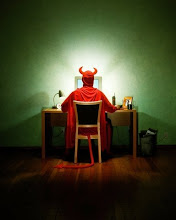
Scott Stoll of Michigan can do some amazing things with paper-mache. Check out his five huge skeleton creatures, each measuring over nine feet tall! Using more than 125 pounds of newspaper and 90 pounds of flour, Scott individually paper-mached each of the skulls, hands and ribs. Everything was then attached to a support frame designed to withstand 50 mph winds.
For those of you who would like to find out more details about Scott's creations, the following comes straight from the horse's mouth...
WATERPROOFING AND DURABILITY- "The props were painted with a waterproofmasonry paint, the kind you use to seal basement walls. The plan was then to apply a poly seal over that, but we ran out of time this year and werefortunate that it did not rain during the days the display was up. I stillhave several papier mache props from 1992, and everything I have built overthe last 5 years is still in fantastic shape. Polyurethane sealants orvarnishes work well. As for durability, the skulls are tough, each weighingclose to 5 lbs and some of the tombstones weigh close to 8 lbs. When handling the props, you would swear they were made from wood, they are thatsolid."
ANCHORING - "The skeleton pieces were attached (with bungee cords for ease ofsetup and teardown) to a support structure made of 2x4's. The 2x4 was thenattached to a 6 ft metal fence post sunk into the ground. The tombstoneswere placed on metal rods via a looped cable tie on the back. Everythingwas secure and nothing was disturbed by wind. I forgot to mention that theskulls rested on a very large spring that was attached to the top of thesupport structure, allowing the heads to nod and bobble in the wind, Think9 foot high bobbleheads and you get the idea. The hands and arms wereattached to a piece of 1x3 that hung from a hook. A counter balance on theopposite end of the hand allowed the arms to freely sway in all directions.Very cool in the breeze."
PAPIER MACHE IN GENERAL- "Numerous papier mache techniques were used tocreate the display. The most versatile technique which was used on thetombstones, skulls, hands and ribcages was papier mache clay. PM Clay is made by tearing newspaper into smalls squares, boiling the paper for severalhours until it starts to fall apart, whisking or mixing the paper until itshreds to the consistency of oatmeal, drying the pulp on large screens, thenfinally putting the dry pulp in a blender to form a light paper "fluff."The "fluff" is then mixed with papier mache paste and a binding agent toform a clay that works well for filling large pieces. The paper was groundfairly coarse for the tombstones creating the stone feeling.There are lots of papier mache paste recipes available on the internetranging from the simple to the complex, each has its own special attributes.My favorite is simple: flour + water = paste. Some of the recipes includeadding linseed oil, chalk, sawdust, white glue, cornstarch, bleach, dishdetergent, drywall joint compound, etc. I used a few different recipes andhave my favorite concoctions.The best method for learning papier mache is to simply do it. Start aproject and see where it goes. This year I used sketches as the startingpoint for the Demon Reapers and kept working them until I got the desiredresult. Another great thing about papier mache is that it is constantly re-workable, if you don't like the result you can keep modifying it untilyou get what you want. Cut away pieces, add pieces, sand, drill, the pieceisn't finished until you decide it is (or run out of time).Overall I was very happy with the end result. As usual I learned a millionthings I would do different next time. The biggest challenge was time. We created everything in six weeks which of course meant we ran out of time.I'm least happy with the paint jobs, that was the last stage and had plannedon using an airbrush outside, but the weather the day we were to paint was horrible so I resorted to painting them by hand with a sponge. The pieces will be repainted before they are displayed again."
To see more images of Scott's display, click here.
and here
Sunday, December 31, 2006
Paper-mache magic
Posted by
"Bones"
at
2:14 PM
![]()
Subscribe to:
Post Comments (Atom)




1 comment:
This pic won the Reader's Digest contest. It is fantastic as is all of his work.
Awesome
Post a Comment